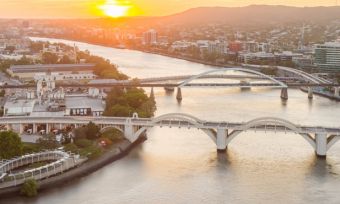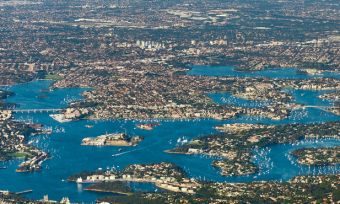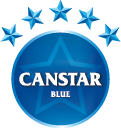Compare the cheapest gas prices in Brisbane, QLD

KEY POINTS
- Based on our calculations, Globird Energy, Red Energy and Alinta Energy are the providers in our database currently offering the cheapest Queensland gas deals for homes consuming an average of 8,300 MJ of gas.
- There are two gas contract types — standard offers and market offers, the former being less competitive than the latter.
- Whether gas is cheaper than electricity depends on how much gas you use and its supply charges.
Note: While we do our best to list up-to-date pricing, it’s vital that you treat the below information as a general guide only. We use a specific set of assumptions for this cost comparison that apply to one particular area of Brisbane. That’s why it’s best to use our gas comparison tool, where you can input your details to unlock a range of quotes available in your area.
Which providers offer the cheapest gas prices in Brisbane?
Our price calculations suggest that Globird Energy, Red Energy and Alinta Energy currently provide the cheapest gas deals in Queensland, with an assumed household gas usage of about 8,300MJ a year.
Gas prices can and do change frequently, and costs will vary depending on a household’s usage habits.
AGN Queensland gas network is the distributor network supplying gas to over 102,000 customers in the Brisbane region (Brisbane CBD, Ipswich) and Northern Region (Rockhampton and Gladstone).
The following information is to be used as a general indicator of prices based on retailers currently listed on our database.
Calculations factor in usage and supply rates, plus any conditional discounts available on the provider’s cheapest market offer.
Cheap gas deals Queensland
Here are some of the cheapest gas deals on our database for QLD. These estimated annual costs are based on the AGN – QLD in Brisbane and yearly gas usage of 8,300 MJ/year, but prices will vary depending on your own circumstances. The products are listed in order of lowest estimated price/year (including conditional discounts), then by the highest value rank (out of 10), then by highest brand satisfaction rating. These are products from referral partners†. Our database may not cover all deals in your area, and please check retailer websites for up to date information.
-
Conditional discounts: 2% off the bill when paid on time plus 1% off the bill for direct debit payments Glossary
-
Ongoing energy plan with no renewal required Glossary
-
No lock in contract with variable rates Glossary
-
Ongoing energy plan with no renewal required Glossary
-
No lock in contract with variable rates Glossary
-
Conditional discounts: 2% off the bill when paid on time plus 1% off the bill for direct debit payments Glossary
-
Ongoing energy plan with no renewal required Glossary
-
No lock in contract with variable rates Glossary
-
12 month energy plan with no exit fees Glossary
-
No lock in contract with variable rates Glossary
-
Ongoing energy plan with no renewal required Glossary
-
No lock in contract with variable rates Glossary
-
Ongoing energy plan with no renewal required Glossary
-
No lock in contract with variable rates Glossary
-
Ongoing energy plan with no renewal required Glossary
-
No lock in contract with variable rates Glossary
-
Conditional discounts: 2% off the bill when paid on time plus 1% off the bill for direct debit payments Glossary
-
Ongoing energy plan with no renewal required Glossary
-
No lock in contract with variable rates Glossary
Advertiser Disclosure
Canstar Blue may earn a fee from its Online Partners for referrals from its website tables, and from sponsorship or promotion of certain products. Fees payable by product providers for referrals and sponsorship or promotion may vary between providers, website position, and revenue model. Sponsorship/promotion fees may be higher than referral fees. If a product is sponsored or promoted, it is an ad and it is clearly marked as such. An ad might appear in different places on our website, such as in comparison tables and articles. Ads may be displayed in a fixed position in a table, regardless of the product’s rating, price or other attributes. The location of an ad doesn’t indicate any ranking or rating by Canstar Blue. Payment of fees for ads does not influence Value Rank or Customer Satisfaction Ratings. See How We Get Paid to find out more.
General Disclosure – Energy
The data in the table is updated within 24 hours of Canstar Blue becoming aware of a change. You can find a description of the initial sort order below the table. You can use the sort buttons at the top of each column to re-order the display. Learn more about our Gas Value Rank Methodology.
Please note that the Satisfaction Rating displayed in the table is a rating relating to customers’ overall satisfaction with the brand. It should not be confused with an individual product rating. Learn more about Brand Satisfaction ratings and for more information on how the Brand Satisfaction ratings are calculated, read the Canstar Blue Most Satisfied Customers Methodology.
The results do not include all energy retailers or products in the market and may not compare all features relevant to you. Canstar Blue does not supply electricity or gas services. If you decide to apply for a particular energy product, you will deal directly with the retailer, not with Canstar Blue. Fees, charges, product information and contract terms should be confirmed directly with the relevant retailer.
Some plans may require you to meet certain conditions before a discount may become available to you. Check the energy provider’s plan information for details of all possible discounts that may apply and any conditions that need to be met for you to be eligible for these discounts.
Check your current plan’s exit fees and other termination provisions before changing providers.
Some plans may have a minimum term that is longer than one year. In that case the total cost over the term will be much higher than the estimated Price, which is for one year only. Consider the provider’s detailed product and pricing information before making a decision to take out a new plan or switch electricity providers.
Pricing Information
The price shown is inclusive of GST and is the estimated lowest possible price a representative customer would be charged in a year for each plan, assuming all conditions of discounts offered, if any, have been met. Gas usage assumptions have been derived from the average usages advertised by a selection of retailers in the distribution region as shown at the top of the table.
The general usage assumptions for products displayed in the table have been derived from:
- the average usages advertised by a selection of retailers in the distribution region as shown at the top of the table. The figures provided are intended to serve as general estimates and should be used for information only. If the amount of gas you actually use differs greatly from this estimate, your bill could be significantly larger or smaller than the estimated price/year listed for each plan; or
- if you have provided usage data from your gas bill, the estimated annual amount payable for this plan is based on your individual circumstances.
The estimated yearly Price is based on single rate tariffs, which is when a flat usage rate is charged for ‘blocks’ of gas consumed and could be a limited amount per day, month, quarter, which may include a second block with a different usage rate applied, or, season.
Some plans may have a minimum term longer than one year – in that case the total cost over the term will be much higher than the estimated yearly Price (which is only for one year).
Some plans may apply additional charges to the price shown. Always check the energy provider’s plan information for details of all charges that may apply.
What does the ‘phone’ mean?
By clicking on the number next to the phone icon, you will leave the Canstar Blue website and be connected with the call centre of the Online Partner’s brand that you have selected. You will be subject to that referral partner’s brand privacy policy and terms of use. You agree that Canstar Blue Referral Terms apply to this referral.
Understanding your gas bill
The two main components of a gas bill are usage charges and supply charges. Depending on the retailer and gas deal, there may also be other fees and charges.
Usage charges
A usage charge refers to the amount of gas a household uses, which is measured in megajoules (MJ). How much you’re charged for your gas usage depends on how it is priced — this pricing structure is known as a ‘tariff’.
Some products will charge gas usage at a single rate or ‘flat rate’, while others may charge gas usage in blocks – known as a ‘block rate tariff’:
- Single rate tariff: Plans on a single rate tariff will be charged the same rate regardless of the time of day or how much gas is consumed.
- Block rate tariff: Block rate tariffs will charge usage according to the quantity of gas consumed, which is measured in ‘blocks’. For example, the first block may be charged 3c/MJ for the first 20MJ used, 2.7c/MJ for the next 20MJ of usage, and 2.5c/MJ for the remainder.
Supply charges
Supply charges cover the cost of being connected to the gas mains or network, and apply regardless of how much gas a household consumes. They are a daily, ongoing charge, typically around 70 to 90 cents per day.
Supply charges can make up a considerable portion of a gas bill, particularly for customers who don’t use a lot of gas.
Discounts
Depending on the gas plan, discounts will either be conditional or guaranteed.
Conditional discounts require customers to satisfy the criteria of a plan, like paying on time, while a guaranteed discount does not require customers to do anything other than pay their bills.
Some discounts will apply to the entire bill (usage and supply charges), while others may only apply to the usage charges.
Other fees and charges
Late payment fees, paper billing fees and credit card surcharges are all types of additional charges that can creep onto a gas invoice.
A breakdown of these fees can be found within the gas price fact sheets.
Type of gas contracts in Queensland
The type of gas contract you’re on will normally determine what’s included in your plan, as well as how competitive the gas rates are. In Queensland, there are two types of gas contracts – standard contracts and market offers.
- Standard contracts: A basic contract regulated by the QLD Government that includes terms and conditions which can’t be changed by the retailer. Customers who haven’t changed gas retailers in a long time will likely be on a standard contract. These contracts are usually less competitive than market offers.
- Market retail offers: Contracts that are set by retailers, often including discounts and cheaper gas rates. Though competitive, market contracts can change rates at the retailer’s discretion, provided customers have been notified in advance. Market offers normally only have a benefit period of 12 or 24 months, meaning customers may be moved onto a standard contract after this period ends.
Is gas cheaper than electricity?
The difference in cost between gas and electricity will usually come down to how much gas a customer uses and natural gas supply charges.
According to energy.gov.au, Queensland uses the least amount of gas per household in Australia. This could explain why there are only a small handful of natural gas retailers in the state, as well as why gas prices are higher than in other states.
Customers with a mains gas supply will need to think about the amount of gas they use, and whether or not it’s worth paying for both gas and electricity. Customers with larger gas consumption needs may benefit the most, while smaller residential households who use gas less frequently could be better off just paying for electricity.
Remember, gas only powers specific appliances within a home, like hot water systems. Given that gas supply charges cost around 70 to 90 cents a day, customers will need to ensure it’s an affordable source of energy on top of household electricity costs.
Which gas supplier is rated highest in Queensland?
Origin is the 2024 winner of Canstar Blue’s annual ‘Best-Rated Gas Suppliers’ award in QLD, receiving five stars for overall satisfaction, along with five stars for its customer service, bill and cost clarity, ease of sign-up and online tools and advice.
While picking on price alone makes sense at times, it shouldn’t be at the expense of something as important as customer service.
That’s why we’ve done most of the homework for you by releasing our annual review of QLD natural gas suppliers. Click the link below and discover the other close runner-ups in Queensland.
Original reporting by Simon Downes
Image Source: Shutterstock.com
This article was reviewed by our Utilities Editor Tara Donnelly before it was updated, as part of our fact-checking process.










